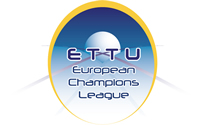| Date | R | Home v Away | - |
|---|---|---|---|
| 02/14 11:00 | 3 | Ttf Dekorglass Dzialdowo v KS Orlicz 1924 Suchedniow | View |
| 02/14 11:00 | 3 | Bogoria Grodzisk Mazowiecki v Solex-Consult Wiener Neustadt | View |
| 02/16 12:00 | 3 | Borussia Dusseldorf v Alliance Nimes Montpellier Tt | View |
| 02/16 14:00 | 3 | FC Saarbucken v Gv Hennebont Tt | View |
Teams
 Patrick Franziska
Patrick Franziska
 Anton Kallberg
Anton Kallberg
 Jonathan Groth
Jonathan Groth
 Andreas Levenko
Andreas Levenko
 Dang Qiu
Dang Qiu
 Pavel Sirucek
Jakub Dyjas
Pavel Sirucek
Jakub Dyjas
 Frane Kojic
Frane Kojic
 Steffen Mengel
Tomas Konecny
Jakub Kleprlik
Jiri Vrablik
Marek Badowski
Steffen Mengel
Tomas Konecny
Jakub Kleprlik
Jiri Vrablik
Marek Badowski
 Tomas Polansky
Jiri Martinko
Tomas Tregler
Viktor Brodd
Tomas Polansky
Jiri Martinko
Tomas Tregler
Viktor Brodd
 Andrej Gacina
Andrej Gacina
 Nandor Ecseki
Nandor Ecseki
 Tomokazu Harimoto
Quentin Robinot
Vladimir Samsonov
Tomokazu Harimoto
Quentin Robinot
Vladimir Samsonov
 Hugo Calderano
Jeongwoo Park
Robert Floras
David Reitspies
Konstantin Chernov
Tobias Rasmussen
Bo Fang
Hugo Calderano
Jeongwoo Park
Robert Floras
David Reitspies
Konstantin Chernov
Tobias Rasmussen
Bo Fang
 Yuto Muramatsu
Sadi Ismailov
Yuto Muramatsu
Sadi Ismailov
 Irvin Bertrand
Irvin Bertrand
 Mihai Bobocica
Michal Bankosz
Mihai Bobocica
Michal Bankosz
 Lubomir Jancarik
Lubomir Jancarik
 Jonghoon Lim
Yannick Vostes
Jonghoon Lim
Yannick Vostes
 Ganghyeon Park
Yu Zhou
Ganghyeon Park
Yu Zhou
 Seungmin Cho
Felipe Olivares
Andriy Sitak
David Serdaroglu
Chia-Hung Sun
Dmitrij Prokopcov
Olav Kosolosky
Hampus Soderlund
Seungmin Cho
Felipe Olivares
Andriy Sitak
David Serdaroglu
Chia-Hung Sun
Dmitrij Prokopcov
Olav Kosolosky
Hampus Soderlund
 Cheng-Ting Liao
Cheng-Ting Liao
 Adam Szudi
Aliaksandr Khanin
Adam Szudi
Aliaksandr Khanin
Wikipedia - European Champions League (table tennis)
European Champions League (ECL) is the seasonal table tennis competition for the highest ranked European club teams and is regarded as the most important international club competition in Europe. It is organised by the European Table Tennis Union (ETTU) and replaced the European Club Cup of Champions (ECCC), the previous prominent club competition, since the 1998/99 season. Originally there was only a men's competition; a women's competition was introduced in the 2005/06 season. The competition starts in September and the champions are usually determined in May in recent years.
German club Borussia Düsseldorf is the most successful club in the history of the men's competition, having won the competition seven times and being the runners-up three times, while Belgian club La Villette Charleroi and Russian club Fakel Gazprom both have won five titles.
In the women's competition, TTC Berlin Eastside from Germany has won the league five times, making it the most successful club.
History
The Men's Champions League was first organised in the 1998/99 season, with the aim to replace the European Club Cup of Champions, the previous highest level European club competition held since 1960/61 season. In the second season (99/00), the playing system was changed. The maximum number of games had been reduced from seven to five, and the double had been cancelled, with the aim of having a better presentation on TV and more excitement for the spectators. The competition came into a new era in 2005/06, when the Women's Champions League started with eight clubs and the men's league was expanded from 8 to 16 clubs, enabling a greater number of nations to participate. These changes were undertaken in the hopes of making table tennis more popular in a European level as well as motivating the coming generation. However, the number of teams in the women's competition decreased from eight to six in season 09/10.
In season 10/11, because of the Great Recession, there were just four teams entering the women's competition, a number lower than the previous year (there were six teams in season 09/10). As a result, the women's competition was suspended for one year. The men's competition was also affected, causing the number of teams to decrease from 16 to 14.
The women's competition resumed in season 11/12, with six teams entering the competition. The number of teams in the men's competition was also restored to 16.
Join us for the exhilarating "Champions League" Table Tennis Tournament, where the best players from around the globe will compete for glory and prestige! This premier event promises to showcase exceptional talent, fierce competition, and unforgettable moments as athletes battle it out on the table.
**Event Highlights:**
- **Date:** [Insert Date]
- **Location:** [Insert Venue]
- **Categories:** Open Singles, Doubles, and Mixed Doubles
- **Participants:** Elite players from various countries, including national champions and rising stars
- **Format:** Round-robin followed by knockout stages, ensuring every match counts
- **Prizes:** Trophies, medals, and cash prizes for top performers
**Why Attend?**
- **Witness World-Class Talent:** Experience the thrill of watching top-tier players demonstrate their skills, agility, and strategic prowess.
- **Engaging Atmosphere:** Enjoy a vibrant atmosphere filled with passionate fans, live commentary, and exciting match-ups.
- **Networking Opportunities:** Connect with fellow table tennis enthusiasts, coaches, and industry professionals.
- **Family-Friendly Event:** Activities and entertainment for all ages, making it a perfect outing for families and friends.
Whether you're a seasoned player, a dedicated fan, or new to the sport, the "Champions League" Table Tennis Tournament promises an action-packed experience that you won't want to miss. Mark your calendars and get ready to cheer for your favorite players as they vie for the title of champion!
